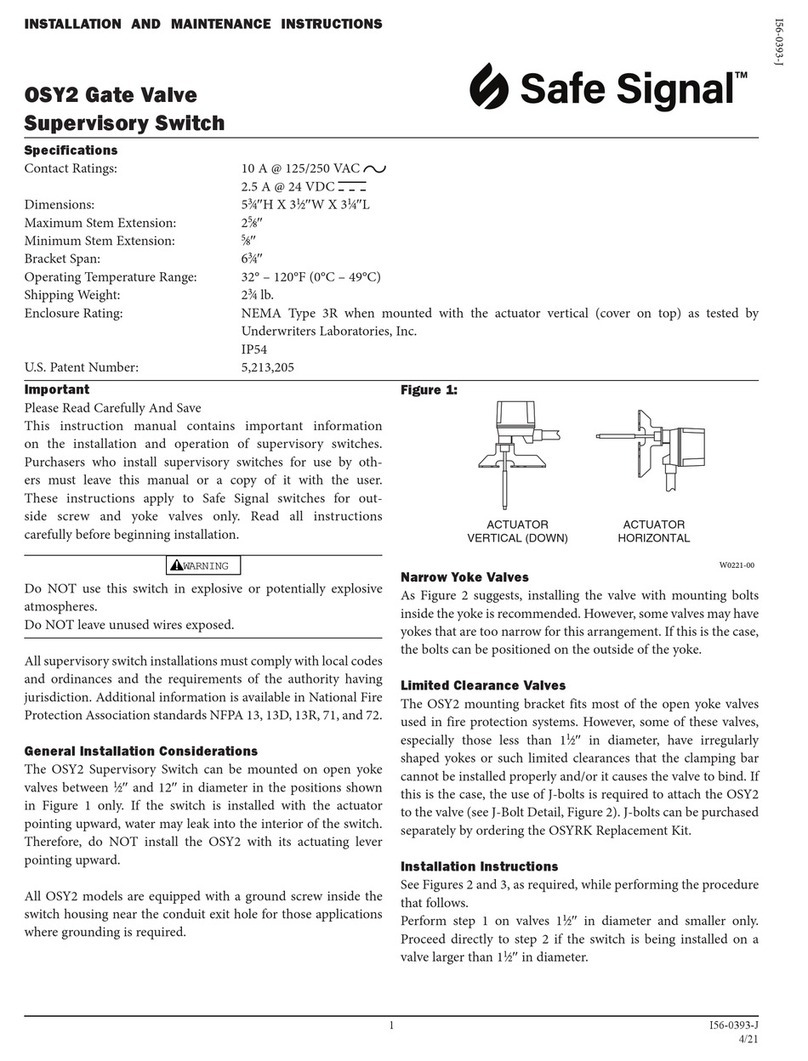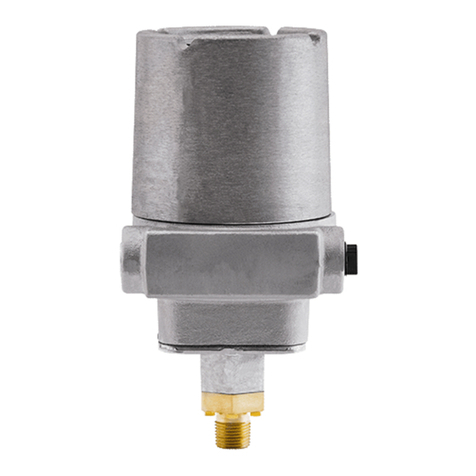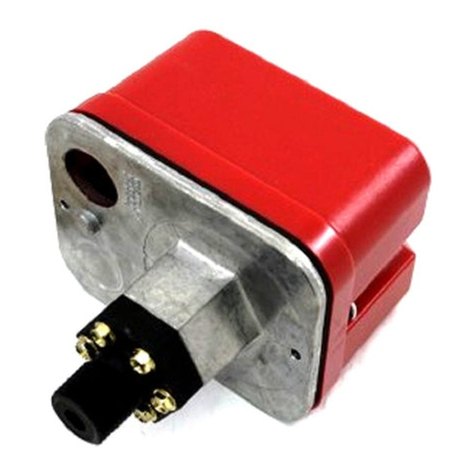
Table 2.
FACTORY SETTINGS ( PSI)
MODEL Fall Sw2
(Low Switch) Nominal Rise Sw1
(Hi Switch)
EPS40EXP 30 ± 1.5 40 50 ± 2.5
EPS120EXP 101.5 - 112.5 115 117.5 - 128.5
Dual-switch Model — EPS40EXP and EPS120EXP
1. Install pressure switch as stated in “INSTALLATION” portion
of instruction manual. Attach pressure test source to system.
2. Remove adjustment wheel cover and back off locking screw
(see Figure 1) to allow main adjustment wheel to rotate freely.
3. Option 1: To adjust the nominal setting of the pressure win-
dow (low switch setting to high switch setting) without affect-
ing the size of the window, adjust the main adjustment wheel,
Figure 1, to the desired setting using the pressure source to
verify each switch setting. Each tine on the wheel represents
an approximate window shift of 1.8 PSI for the EPS40EXP
and 6.6 PSI for the EPS 120EXP. For each 1/2 rotation of the
adjustment wheel, the window changes by approximately 11
PSI for the EPS 40EXP and 40 PSI for the EPS 120EXP.
Option 2: To adjust the pressure window size and the nominal
setting of the pressure window, adjust the main adjustment
wheel, Figure 1, until the high switch (SW1) trips at the
desired pressure using the pressure test source. Decrease the
pressure until the low switch (SW2) trips. Note pressure and
determine how much change is desired on the low switch.
Adjust the 1/4
″
hex screw, Figure 1, to either increase (coun-
terclockwise) or decrease (clockwise) the window size. (The
low switch will be affected.) The approximate sensitivity of
the hex screw adjustment: 1/2 turn = 5 PSI. An approximate
maximum window size of 30 PSI is obtainable. Retest the high
switch after adjusting the low switch.
4. Retest the set points several times to ensure the accuracy of
the settings.
5. Re-seat locking screw.
6. Re-install adjustment wheel cover.
NOTE: The sensor assembly is not field replaceable. Do not
attempt to disassemble these parts. If you have any
questions, consult Safe Signal. Safe Signal recom-
mends careful consideration of the following factors
when specifying and installing Alarm and Supervisory
Pressure Switches. Always refer to the Installation and
Maintenance Instruction for specific recommendations
on individual devices before installing the unit.
• Electrical ratings stated in literature and on nameplates
should not be exceeded.
• Overload on switch can cause failure on the first cycle.
Always wire devices according to national and local electri-
cal codes.
• Install units away from shock and vibration. Proper electri-
cal fittings should be used to prevent moisture from enter-
ing the enclosure via the conduit.
• Test all devices for proper operation after initial installa-
tion. Perform preventive maintenance and periodic testing
as required by the applicable NFPA standards but not less
than bi-monthly.
• Install a back-up control for all critical applications where
control failure could endanger life or property. A backup
control to serve as a high or low limit control is especially
recommended for applications where a runaway condition
could result.
• Do not mount unit where ambient temperatures will
exceed published limits.
• Avoid impact or mechanical loading.
THREE-YEAR LIMITED WARRANTY
SAFE SIGNAL warrants that the equipment herein shall conform to said descriptions as to all af-
firmation of fact and shall be free from defects of manufacture, labeling, and packaging for a pe-
riod of three (3) years from the invoice date to the original purchaser, provided that representative
samples are returned to SAFE SIGNAL for inspection. Upon a determination by SAFE SIGNAL
that a product is not as warranted, SAFE SIGNAL shall, at its exclusive option, replace or repair
said defective product or parts thereof at its own expense except that Purchaser shall pay all
shipping, insurance, and similar charges incurred in connection with the replacement of the
defective product or parts thereof. This Warranty is void in the case of abuse, misuse, abnormal
usage, faulty installation, or repair by unauthorized persons, or if for any other reason SAFE
SIGNAL determines that said product is not operating properly as a result of causes other than
defective manufacture, labeling, or packaging.
3 I56-1428-C
4/21























